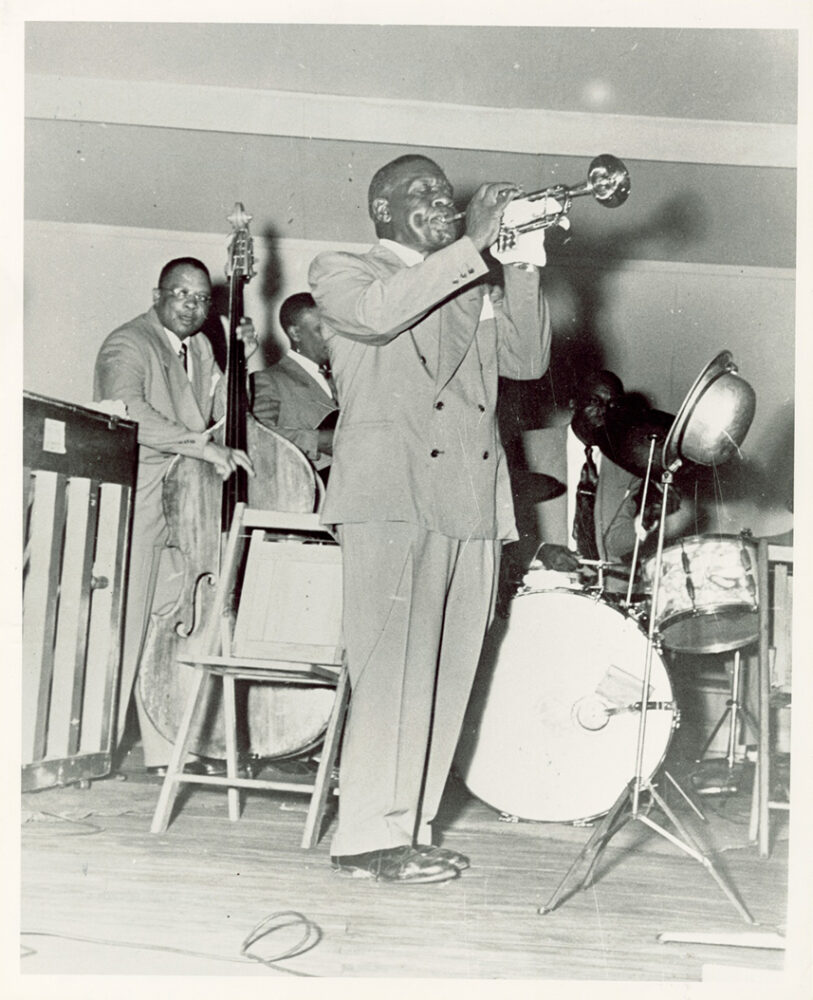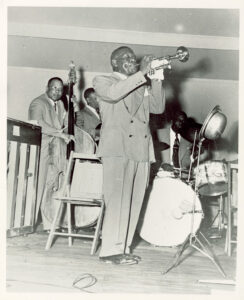Papa Celestin
Cornetist and trumpeter Oscar Phillip “Papa” Celestin was a jazz pioneer and beloved bandleader and entertainer.

The Historic New Orleans Collection
Oscar “Papa” Celestin Playing Trumpet
Oscar Phillip “Papa” Celestin was a cornetist and trumpeter whose greatest contribution to New Orleans culture was less as a musician and more as a popular bandleader and personality. He left music and worked as a laborer during the Great Depression, but reentered the jazz scene after World War II when he was in his sixties. It was in this latter period, during the 1950s revival of traditional New Orleans jazz and Dixieland jazz, that Celestin became a major figure, appearing regularly with his band at the Paddock Lounge on Bourbon Street in the French Quarter. He performed at the White House in 1953, and in 1954, at his final recording session, recorded “Marie Laveau,” an ode to the legendary New Orleans voodoo queen that has remained a favored entry in the New Orleans songbook.
Celestin’s late-career celebrity obscures a more significant personal legacy as the innovative and highly successful leader of the Tuxedo Jazz Band. The band, whose name variations included the Tuxedo Jazz Band, Tuxedo Jazz Orchestra, and Celestin’s Original Tuxedo Orchestra, began in 1910 and continues to perform more than a century later as the Original Tuxedo Jazz Band. “Under [Celestin’s] command, the Tuxedo was one of the first jazz bands to record in New Orleans,” wrote Dr. Bruce Boyd Raeburn, longtime curator of the Hogan Jazz Archive at Tulane University. “It was instrumental in the organization of Local 496, the Black American Federation of Musicians union in New Orleans” and “one of the earliest jazz bands to employ women regularly (as pianists) . . . and it built a loyal following that spanned conventional racial and ethnic categories by providing infectious dance music that was popular from the bottom of society to the top.” The band’s accomplishments, Raeburn added, “were not so much the product of strategic planning as they were the result of Celestin’s open-minded and endearing manner of dealing with the people he encountered in everyday life.”
From the Plantation to the City
Celestin was born on January 1, 1884, in Napoleonville, Assumption Parish. A Creole of color, his father was a sugarcane cutter, and young Oscar would work on sugar plantations as a youth before acquiring a job as cook on the Texas and Pacific Railway. Working at the railroad company, he earned enough money to pursue his interest in music, buying a guitar and trombone before settling on the cornet. The budding musician also took lessons from one of several music teachers who traveled from New Orleans to outlying areas to teach youngsters who aspired to careers in music. Celestin performed with local bands before his move to New Orleans in 1906 at age twenty-two. The six-foot-four-inch, three-hundred-pound musician worked on the city’s docks as a longshoreman while searching for a way into the local music scene.
Displaying his innate ability to create multiple alliances, Celestin performed spot gigs alongside Joe “King” Oliver, Jelly Roll Morton, Bunk Johnson, Peter Bocage, and others. He played cornet in the Imperial Band, the Crescent City Orchestra, and, occasionally, the Olympia Orchestra. In 1908 he played with the last band of Buddy Bolden, the popular Henry “Red” Allen Brass Band. The following year he was hired to play at Anderson’s Fair Play Saloon on Basin Street, near the entrance of the city’s red light district, Storyville. In 1910 Celestin joined the house band at the Tuxedo Dance Hall in Storyville. His singing, playing, and engaging stage persona earned him leadership of the band, which he named the Tuxedo Orchestra. At the Tuxedo Dance Hall, Celestin developed a reputation for hiring exceptional musicians as well as showcasing his comedic talents. The Daily Picayune newspaper took note: “The leader at the Tuxedo was the pride of the house. Harry Lauder, Billy Van, or George Evans never had anything on him in funny facial expressions or funny twists of the legs. When he led the band, people stopped to watch his antics.”
A Dance Band and a Marching Brass Band
In addition to creating what many acknowledged to be New Orleans’s best dance band, Celestin founded the popular Tuxedo Brass Band in 1911. (Although Celestin’s brass band kept “Tuxedo: in its name, it was separate from the dancehall-oriented Tuxedo Jazz Band.) Many historians consider the Tuxedo Brass Band’s ability to play written and improvised music with equal ease a breakthrough in the development of jazz. New Orleans brass band historian Richard Knowles observed: “ . . . the two traditions, playing from written music and improvising, came together, and they came together in one band in particular, the Tuxedo . . ..The Tuxedo dominated the brass band scene in New Orleans in the first half of the 1920s, playing ‘heavy music’ (carefully arranged scores) when called on, but also including in their repertoire popular tunes of the day, which they played ‘by ear’ . . .. The more modern approach meant that the Tuxedo Brass Band quickly became the busiest and most popular band in the city.”
A Second Career
Celestin and the Tuxedo Brass Band are also remembered for a specific moment in jazz history. In 1923, on the same day that a supremely talented young trumpeter named Louis Armstrong received a telegram from his mentor and former employer, Joe “King” Oliver, Armstrong played one of his last New Orleans gigs with the Tuxedo Brass Band. The Tuxedo’s members were among the first to hear that Oliver had asked Armstrong to join him in Chicago. Monetarily, it was an offer Armstrong couldn’t refuse.
After the Tuxedo Brass Band’s great success in the 1920s, the band’s fortunes faded in the Depression-era 1930s. Celestin returned to his longshoreman work but continued playing weekends and private events. During World War II, he led the Tuxedo Jazz Orchestra while working as a welder in a shipyard. In 1944 a truck ran over Celestin in the shipyard, shattering his legs. The injuries required a year-long hospital stay and lengthy recuperation at home.
The traditional jazz revival that began after World War II as well as the National Jazz Foundation helped jazz music and, specifically, the Tuxedo Jazz Orchestra, return to prominence in New Orleans and beyond. As Tuxedo Jazz Band biographer Sally Newhart notes: “Bourbon Street in the late 1940s and early 1950s was the epicenter of the New Orleans jazz revival.” In 1947 Celestin’s Original Tuxedo Orchestra returned to the studio, recording for New Jersey’s Deluxe Records. Achieving a remarkable comeback, Celestin’s band became the most popular band in New Orleans. Jazz fan Abagail Arnold said in a 1958 Hogan Jazz Archive interview, “For dances from 1950s to 1953, the majority of social functions, everybody was trying to get Celestin.”
On May 8, 1953, Celestin and the Original Tuxedo Jazz Band became the first New Orleans jazz band to perform at the White House. During the annual White House Correspondents’ Association banquet, Celestin received the association’s Certificate of Honor. “I feel that I have made a wonderful mark and a wonderful success as a native-born Southerner to have the opportunity to play at this dinner,” he said. President Dwight D. Eisenhower shook the jazz pioneer’s hand after the band’s performance, saying: “Mr. Celestin, you are a fine gentleman and a credit to your race and our country.” Celestin called his compliment-filled encounter with the president the proudest moment of his life.
On December 15, 1954, seventeen months after his triumph in Washington, DC, Celestin died at age seventy from cancer at his home on France Street. An estimated ten thousand spectators watched his funeral procession on Canal Street, as a four-thousand-strong second line followed fifteen black limousines, while the Eureka Brass Band and members of the original Tuxedo Brass Band played “Just a Closer Walk with Thee.”
